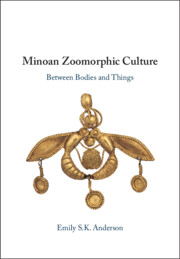883 results
Response of indicator species to changes in food web and ocean dynamics of the Ross Sea, Antarctica
-
- Journal:
- Antarctic Science , First View
- Published online by Cambridge University Press:
- 19 September 2024, pp. 1-29
-
- Article
-
- You have access
- Open access
- HTML
- Export citation
Older Adults in Psychedelic-Assisted Therapy Trials: A Systematic Review
-
- Journal:
- European Psychiatry / Volume 67 / Issue S1 / April 2024
- Published online by Cambridge University Press:
- 27 August 2024, p. S232
-
- Article
-
- You have access
- Open access
- Export citation
Six - Moving toward Life
-
- Book:
- Minoan Zoomorphic Culture
- Published online:
- 17 May 2024
- Print publication:
- 06 June 2024, pp 310-371
-
- Chapter
- Export citation
Two - Craftiness and Productivity in Bodily Things
-
- Book:
- Minoan Zoomorphic Culture
- Published online:
- 17 May 2024
- Print publication:
- 06 June 2024, pp 38-101
-
- Chapter
- Export citation
Concluding Thoughts
-
- Book:
- Minoan Zoomorphic Culture
- Published online:
- 17 May 2024
- Print publication:
- 06 June 2024, pp 372-379
-
- Chapter
- Export citation
Acknowledgments
-
- Book:
- Minoan Zoomorphic Culture
- Published online:
- 17 May 2024
- Print publication:
- 06 June 2024, pp viii-x
-
- Chapter
- Export citation
Contents
-
- Book:
- Minoan Zoomorphic Culture
- Published online:
- 17 May 2024
- Print publication:
- 06 June 2024, pp vii-vii
-
- Chapter
- Export citation
Index
-
- Book:
- Minoan Zoomorphic Culture
- Published online:
- 17 May 2024
- Print publication:
- 06 June 2024, pp 408-418
-
- Chapter
- Export citation
Copyright page
-
- Book:
- Minoan Zoomorphic Culture
- Published online:
- 17 May 2024
- Print publication:
- 06 June 2024, pp iv-iv
-
- Chapter
- Export citation
Dedication
-
- Book:
- Minoan Zoomorphic Culture
- Published online:
- 17 May 2024
- Print publication:
- 06 June 2024, pp v-vi
-
- Chapter
- Export citation
Four - Likeness and Integration among Extraordinary Creatures
-
- Book:
- Minoan Zoomorphic Culture
- Published online:
- 17 May 2024
- Print publication:
- 06 June 2024, pp 159-245
-
- Chapter
- Export citation
Chronology
-
- Book:
- Minoan Zoomorphic Culture
- Published online:
- 17 May 2024
- Print publication:
- 06 June 2024, pp xi-xii
-
- Chapter
- Export citation
References
-
- Book:
- Minoan Zoomorphic Culture
- Published online:
- 17 May 2024
- Print publication:
- 06 June 2024, pp 380-407
-
- Chapter
- Export citation
One - Life among the Animalian in Bronze Age Crete and the Southern Aegean
-
- Book:
- Minoan Zoomorphic Culture
- Published online:
- 17 May 2024
- Print publication:
- 06 June 2024, pp 1-37
-
- Chapter
- Export citation
Five - Singular, Seriated, Similar
-
- Book:
- Minoan Zoomorphic Culture
- Published online:
- 17 May 2024
- Print publication:
- 06 June 2024, pp 246-309
-
- Chapter
- Export citation
Three - Stone Poets
-
- Book:
- Minoan Zoomorphic Culture
- Published online:
- 17 May 2024
- Print publication:
- 06 June 2024, pp 102-158
-
- Chapter
- Export citation
The Rapid ASKAP Continuum Survey III: Spectra and Polarisation In Cutouts of Extragalactic Sources (SPICE-RACS) first data release – CORRIGENDUM
-
- Journal:
- Publications of the Astronomical Society of Australia / Volume 41 / 2024
- Published online by Cambridge University Press:
- 03 June 2024, e039
-
- Article
-
- You have access
- Open access
- HTML
- Export citation
Evolutionary map of the universe (EMU): Observations of filamentary structures in the Abell S1136 galaxy cluster
-
- Journal:
- Publications of the Astronomical Society of Australia / Volume 41 / 2024
- Published online by Cambridge University Press:
- 23 May 2024, e050
-
- Article
-
- You have access
- Open access
- HTML
- Export citation

Minoan Zoomorphic Culture
- Between Bodies and Things
-
- Published online:
- 17 May 2024
- Print publication:
- 06 June 2024
The contribution of cannabis use to the increased psychosis risk among minority ethnic groups in Europe
-
- Journal:
- Psychological Medicine , First View
- Published online by Cambridge University Press:
- 09 May 2024, pp. 1-10
-
- Article
-
- You have access
- Open access
- HTML
- Export citation


